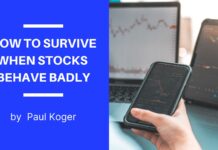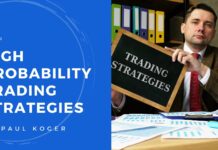Table of Contents
Should you day trade or ride the swings of the market? This is an important question every budding trader must answer in his/her first few weeks in the market.
The frequency and time frame of each trade has a huge and often overlooked impact on your account. Scalping, for instance, can increase profit potential but not without increasing the inherent risks as well.
As for the question of which is better as a trading style – day trading versus swing trading – it requires a comprehensive look at the pros and cons and the individual qualities that make up each style in order to make the most informed choice possible.
Work Required

Day trading is a more hands-on practice, with most day traders getting up as early as 5 in the morning to prepare their charts. This is not a neccessity but proper preparation can give you a handsome edge over other traders.
You’ll have to manage your time wisely in order to continuously analyze the market and make rapid decisions as new patterns and economic news unfold all while performing your other personal and professional responsibilities.
You will most likely trade during specific hours of the day, such as early mornings or late nights.
Of course, it is completely possible to trade all day and, in fact, a lot of people do it. This, however, can lead to more frustrations, stress, and, eventually, burnout.
Swing trading, on the other hand, demands less hours of your day. It gives you more moments and space away from your desktop computer or laptop.
You aren’t tethered to the markets and blips on the screen. Albeit, you still have to watch the stocks to make sure key levels are intact.
As a part-time gig, swing traders can make substantial gains while being spared from the myriad of decisions that day traders are confronted with.
It’s still expected for both types of traders to create and follow an extensive trading plan with entry and exit levels.
Profit Potential

Perhaps the foremost reason why people choose to day trade is the allures of making more money over a shorter period of time. You are basically getting in and out of a trade in the course of minutes or hours.
Five-minute and one-hour price charts are often used by day traders to gain perspective of where prices are moving in the next few hours.
This high-frequency approach can lead to dozens of trades per day, all of which attempt to make a few percentage points per roundtrip trade.
When you do day trades, make sure to have a set target profit in mind. The daily price fluctuations of financial markets can be unpredictable and therefore booking your profits when it hits the predetermined price levels is sensible and makes strategic sense in the long run.
Swing trades, on the other hand, aim for a much bigger profit potential per roundtrip trade.
In Forex, this can translate to profit targets of 20 to 50 pips. For stocks, the average you can shoot for is 10 percent or more, depending on your risk appetite.
The lifespan of a swing trade can range anywhere from two days to two weeks. And since you are allocating funds at a longer time frame, it makes sense to target more to make the trade worthwhile taking.
Parking your available capital and only gaining a few percentage points after several weeks is simply unsustainable and doesn’t leverage your capital to its fullest potential.
Data Used to Trade

A trade is only as good as the data backing it up. When comparing day trading vs swing trading, data-wise that is, the resources and tools used can widely vary.
For day traders who scalp, fundamental news and economic reports like interest rate hikes and employment numbers tend to be irrelevant and unsuitable for your chosen style since it takes time for results to reflect itself on price.
Most day traders use technical analysis, consisting of indicators like moving averages, Stochastics, and Bollinger bands.
Since they operate within longer time frames, swing traders can use a combination of technical and fundamental analysis, and sometimes even market sentiment. The latter pertains to how participants – both retail traders and institutional traders – are approaching the financial market, risk-wise.
Are they taking greater risks because of recent positive developments in the company? Or are they saving their funds and sitting on the sidelines in fear of a brewing economic turmoil?
An example of a tool swing traders can use is a Bollinger band set on a high time frame, such as a 4-hour or daily chart. For increased filtering and accuracy of trade ideas, you can combine it with major psychological levels that act as support or resistance for price.
Risk Management

Risk for day traders are substantially higher, especially if you are scalping on a daily basis, compared to swing traders.
In a scalping scenario wherein a trader is looking to close a trade after a profit of 3 to 5 percentage points, keep in mind that he/she is also paying for broker’s commissions.
Assuming you are trading Forex, a one standard lot trade on New Zealand’s Kiwi versus the US Dollar can see you paying anywhere between $20 to $30, depending on the broker’s offered spreads, just as a commission fee.
This means the trade will need to move at least two or three pips in your favor before you can even start making any actual profit.
Swing traders usually get more leeway when it comes to risk. Since they stay for a longer period of time in any given trade, they are free from the risks inherent in daily price volatility and instead capitalize on larger stretches of price movement in their favor.
That being said, swing traders aren’t immune to risk. In fact, they may even sustain heavier dollar losses per trade.
Because profit targets are usually far from where they initially buy or short the asset, the stop loss is also usually increased to account for short-term price volatility.
Say a swing trader is targeting a 20 percent profit on his/her trade, they might go for a 5 or 10 percent stop loss to avoid getting stopped out prematurely.
Capital Required

Day trading vs swing trading aside, the capital required should depend predominantly on how much cash you are comfortable losing without affecting your lifestyle and ability to take care of yourself and your family.
Perhaps the only important fact to consider when it comes to capital requirements is when you plan to day trade stocks.
The minimum account size required by FINRA is $25,000. This is neccessary if you want to become a proper day trader, moving in and out of stocks daily.
You are, however, allowed to make three day trades per week if you have a smaller account. If you exceed this limit, your account is margin called by your broker.
To make a swing trade venture worthwhile taking, it’s reasonable to have at least $2,000 to trade with.
After all, you’ll be holding the position for days to weeks on end. As your trade moves in your favor, you can reinvest the profits to buying more of the asset, assuming that your trade idea is still valid at that point and that the trend is continuing its direction.
Avoid basing the decision of how much you should put on your account on broker offerings.
It can be tempting to open a trading account with those $50 basic accounts, but you can easily burn through the money since you’ll have to compensate for the limited capital through overtrading and improper risk management practices.
Personality Compatibility

Trading in its purest essence is simply human emotion. All the blips and price movements manifest what people are thinking and how they are feeling about that particular asset.
While technical and fundamental data help fuel activity, human emotions are at the core of every trade opened and closed. Hence, it’s important to pick a trading style that is most compatible with your personality.
Ask yourself how much you are willing to risk, what your risk appetite is, and if you can handle the day-to-day stress of trading.
Fears of missing out on a potentially good trade, of getting stopped out only for price to bounce back to your direction, and whatnot are all psychological barriers that can impede you from practicing proper risk management and executing your trading plan flawlessly.
If you can stay perfectly calm and think logically without letting your emotions get in the way of closing a losing trade, you can probably do it on a daily basis.
On the other hand, if you are risk averse and prefer to avoid the confusing and unforgiving daily price movements of the financial markets, operating as a swing trader can be a more suitable position for you.
Final Thoughts
Whether you choose to day trade or swing trade, future success as a trader depends on the coalescence of a well thought out trading plan, risk management, and discipline.
The core principles and jargon of trading are very simple to grasp. At the end of the day, it’s how you use and react to the information that the market presents you that makes all the difference in your bottom line.








![Etoro Review – My Honest Opinion [+TUTORIALS]](https://foxytrades.com/wp-content/uploads/2018/03/Etoro-Review-100x70.jpg)

Excellent article, thank you for the overview.